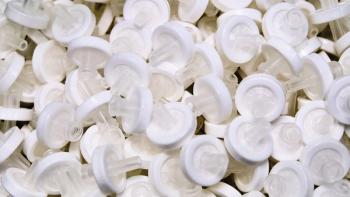
- BioPharm International-05-01-2011
- Volume 24
- Issue 5
Bioengineered Protein A Polymer Beads for High-Affinity Antibody Purification
The authors discuss an alternative to traditional Protein A resins.
Current purification of monoclonal antibodies (mAbs) as therapeutic agents relies on protein A affinity chromatography as one of its key process steps (1–4). The rapidly growing market for this class of high-value therapeutic agents makes its production process an important target for improvement. As cell lines have been engineered to produce increased titers of mAbs, the actual purification process increasingly becomes a bottleneck.
Protein A resins have greatly simplified the mAb recovery process but they are expensive, often costing millions of dollars, and their current binding capacities are insufficient to meet the needs of cell lines producing higher titers of mAbs. Currently used protein A resins are made of recombinant protein A or recombinant multiple Z–binding domains comprising derivatives of protein A that are both recombinantly produced by bacterial fermentation, purified and then chemically cross-linked to premade agarose beads. The implementation of multiple and laborious steps in the production process of protein A resin is reflected in its high retail price. The current manufacture of protein A resin inherently contributes to its limited performance. The chemical cross-linking of the protein A ligand to agarose leads to a random orientation of the ligand, and hence a loss of accessible binding sites, and a reduction of the mAb binding capacity. The protein A sepharose as porous affinity resin requires diffusive flow of the mAb solution that, in turn, increases the residence time of the mAb. Increased processing time not only impairs the economics of the production process but also facilitates enzymatic breakdown of mAbs (5).
ALL FIGURES COURTESY OF THE AUTHORS
COST-EFFECTIVE, ONE-STEP PRODUCTION OF NOVEL PROTEIN A–BASED RESINS
A new expression platform technology has been developed for the one-step production of protein A–based ligands already cross-linked to polyester beads. Escherichia coli has been successfully engineered to manufacture polyester beads that display multiple copies of the protein A–derived and antibody-binding Z domain (6). This new technology harnesses the natural polyester storage granule formation process inside bacteria for the production of ligand coated polyester beads (7) (see Figure 1). The polyester synthase (PS), which mediates polyester synthesis and bead formation, remains covalently attached to the polyester bead surface. PS was engineered to efficiently display multiple Z domains. A hybrid gene encoding the PS–Z domain fusion protein was constructed and introduced into E. coli harbouring the two genes phbA and phbB from Ralstonia eutropha. The phbA and phbB genes mediate conversion of the central metabolite acetyl–CoA to the activated polyester precursor, which is converted to polyester beads by the activity of the PS–Z domain fusion protein. This genetically engineered E. coli enabled efficient production of polyester beads displaying the PS–Z domain fusion protein at high density and functionality. These polyester beads (PolyBind–Z) were extensively analysed using gas chromatography-mass spectrometry and denaturing gel electrophoresis combined with matrix-assisted laser desorption/ionization time-of-flight mass spectrometry (MALDI–TOF–MS). Initial performance testing using Enzyme-linked immunosorbent assay (ELISA), fluorescence-activated cell sorting (FACS), and batch purification combined with protein quantification revealed a specific and high binding capacity for human immunoglobulin G (IgG) and various mAbs (6–8).
Figure 1: Transmission electron microscopy image of engineered E. coli showing accumulation of intracellular polyester beads (PolyBindâZ).
Current commercial technologies for the manufacture of protein A resins require the fermentative production of protein A or its derivatives, the production of a carrier (i.e., agarose beads), and ultimately chemical cross-linking of the target protein to the carrier. This usually leads to random orientation of the protein accompanied by a decrease in specific activity/function, and requires the tedious removal of the often toxic cross-linker. Homogenous functional orientation and elimination of the need for cross-linker removal suggest further advantages of this new polyester bead-based technology. The upstream and downstream processing (see Figure 2) along with the superior functional performance of PolyBind–Z in high affinity bioseparation of antibodies will be discussed.
Figure 2: Upstream and downstream production schematic for PolyBindâZ.
OBTAINING HIGH CELL DENSITY CULTURES FOR ECONOMIC PRODUCTION OF POLYBIND–Z
Commercialization of biopolyesters and biopolyester-derived products has been slow because of the excessive cost of production. However, production of biodegradable polyesters as commodity products has become economically feasible due to a significant amount of applied research and engineering on bacterial production strains and fermentation methods, allowing high cell density E.coli fermentations up to 190 g/L dry cell weight (7, 9–11). Today, E. coli genetically engineered to overproduce biopolyesters as renewable commodity plastics have been reported to accumulate polyester levels approaching 80% of the dry cell weight. Further, volumetric productivity for commodity plastics using commercial technologies has reached levels above 3 g/Lxh.
Here, the authors describe a new platform technology that uses biodegradable biopolymer beads as the carrier for the presentation of a functional PS–Z fusion protein, increasing the complexity of the product. Given that this platform technology incorporates functional proteins presented on the surface, productivity assessment of the PolyBind–Z beads inherently includes functionality. Initial fermentations produced low yields of PolyBind–Z beads (25%–30% of the dry cell weight) that displayed IgG binding functionality in the range of 30 mg/g of drained beads. To increase E.coli cell density, productivity, and functionality of the PolyBind–Z beads, the fermentation conditions, as well as the IgG binding fusion protein, were examined and modified.This resulted in a scalable industrial fermentation process for high-performance PolyBind–Z. Using a fed-batch strategy and incorporation of a defined media lacking animal products, the volumetric productivity of the PolyBind–Z beads has reached levels of approximately 50% when compared with commercial commodity bioplastics production processes. Further, the specific IgG binding functionality (discussed below) of the PolyBind–Z beads was also significantly improved to 100 mg/g of drained beads.
While significant advances have been achieved in the production of highly functional PolyBind–Z beads, the current production process holds the promise to be further optimized. To increase the productivity of our system and approach levels obtained by the commercial commodity bioplastics industry, additional fermentation optimization studies using quality-by-design are underway.
CURRENT DOWNSTREAM PROCESSING: LYSIS AND REMOVAL OF IMPURITIES
Although this platform technology has allowed the development and production of tailor-made highly functional biobeads, a substantial practical and financial hurdle must be overcome. As with many products generated that use microorganisms in their production process, the intracellular polymer or protein must be extracted and purified from the host cell components by an economically feasible process. Fortunately, there are a number of scaled extraction technologies currently used by both industries that can be applied to the extraction of PolyBind–Z beads. These technologies include both mechanical disruption and chemical/enzymatic extraction. However, in contrast to the commodity bioplastics industry, extraction and purification of the PolyBind–Z beads requires retention of protein function. Inherent to the platform technology is a significant proportion of covalently linked surface protein. As a result, the chemicals/solvents applied by the commodity bioplastics industry to extract and purify biopolyester, such as chloroform, butyrolacetone, and sodium hypochlorite, are not viable with this platform; such chemicals would damage the functional proteins displayed on the surface of the biopolymer beads. However, incorporating some of the advances in industrial scale cell disruption and extraction techniques, we have developed a method that uses several different technologies to efficiently disrupt E. coli cells and to release PolyBind–Z.
Once the PolyBind–Z beads are extracted from the E.coli, a stringent purification process is required. Given the resin purity required for the mAb production process, purification of the PolyBind–Z beads to remove host cell proteins (HCPs), nucleic acids, and endotoxins is critical. Informed by already designed and industrially-used protein inclusion body purification processes, we have developed scalable purification steps to remove the majority of the HCPs, nucleic acids, and endotoxins (see Table I). The impurities and contaminants are continuously monitored using sensitive biopharmaceutical standard methods as we further develop the purification process to reduce the impurity levels associated with the beads to levels acceptable by the industry (12).
Table I: Current PolyBindâZ impurity profile.
POLYBIND–Z: AN UNUSUAL PROTEIN A RESIN AND ITS APPLICATION PERFORMANCE
For decades, the biologics industry has relied on packed-bed chromatography as the gold standard for antibody capture. Well-known, understood, and characterised materials and processes have enabled antibody manufacturers to manage the capture step of antibodies with predictable outcomes. The primary issue with traditional protein A sepharose media is that it is costly, requiring multiple cycles to reduce the overall cost contribution of the media to the final product. The need for these additional cycles has further complicated the process by requiring the introduction of wash, regeneration, sanitization, and validation steps to bring media costs to an acceptable level. Standard, packed-bed chromatography operates with pressures in the 0.1–0.4 MPa range, which is enabled because of the size, rigidity, and porosity of their solid supports. Typical commercial offerings are composed of beads that are usually >100 μm in diameter and that allow sufficient interstitial space for adequate flow rates. Balancing the high flow rate of larger particles and maintaining sufficient binding capacity is achieved by managing the porosity of the solid supports, effectively increasing surface area as well as increasing binding times due to diffusion of the target into the pores.
The functional beads can be delivered in a variety of formats in addition to bead slurries, based on initial experimental data One goal of our work has been to process the beads in such a way that their morphology is controlled, avoiding some of the limitations of the basic small particles, such as unsuitability for packed-bed columns or expanded-bed chromatography. In experiments, we processed the particles into fibres to be used as coatings, or cast into membranes. This work opens up a range of potential formats for the material for use alone or in combination with other materials, and processes. In addition to the use of the material for capture of antibodies, the same material could be used to remove impurities, or to catalyze reactions through the surface display of other binding proteins or enzymes, respectively.
We have developed simple batch purification protocols that allow the basic beads to be used in research or small-scale settings. Because of the surface display of the ligands, target binding is rapid and efficient, typically binding greater than 90% of the antibody in less than 30 seconds. This demonstrates the advantage of convective interaction over the current diffusive flow processes. Centrifugation at low speeds, <5000 x g, allows the beads to be resuspended and washed. A disadvantage in packed-bed chromatography, the beads' compressibility is an advantage when used in Eppendorf tubes because after binding, washing, and antibody release from the beads, they can be spun down (10,000 x g) to a point where they do not readily resuspend, allowing removal of the supernatant without aspiration of any beads.
For commercial-scale application, we have seen early promise with the beads in a cross-flow filtration system. Initial experiments indicate this approach would be suitable for production- scale application of the particles in the capture of antibodies to produce a truly disposable harvest format.
Figure 3A: Static Immunoglobulin G (IgG) binding capacity (Eluted IgG in mg/g of drained beads). PB represents PolyBatics PolyBindâZ, 1 and 2 represent commercial protein A agarose beads. Binding capacity is in mg of human IgG/g of drained beads.
The engineered beads exhibit both high binding capacity and excellent specificity, with beads routinely exhibiting binding capacities in excess of 100 mg/g of drained beads (see Figure 3A). This level of binding represents a doubling of the published binding capacities of common commercial offerings, and is an artifact of the combined high surface-to-volume ratio and engineering of the fusion partners to exhibit more of the binding domains at the surface of the particles. We demonstrated the relative binding capacity of the PolyBind–Z versus two commercial offerings (see Figure 3A). In one example, we used 50 mg of drained PolyBind–Z to bind 5 mg of human IgG equating to a total binding of 100 mg/g drained PolyBind–Z beads (see Figure 3B).
Figure 3B: Commassie stained polyacryamide gel of unbound and elution fractions from a representative static hIgG binding experiment. 5 μg of purified huIgG (1 mg/ml) was incubated with 50 μg of either PolyBatics control beads (Lanes 3 and 4), Protein A sepharose beads (Lanes 6 and 7) or PolyBindâZ beads (Lanes 9 and 10) then eluted with equal volumes of a low pH buffer. Equal volumes of sample were loaded into each lane. Lane 1: Biolabs Ladder; Lane 2, 5 and 8: Pure IgG (5 μg); Lanes 3, 6 and 9 represent unbound fractions; Lanes 4, 7 and 10 represent elution fractions.
In the case of the basic bead configuration, we displayed several of the Z–binding domains from protein A per engineered PS. It is also possible to combine specific binding domains, as one prototype combined the Z–binding domain of protein A with the GB1 binding domain of protein G to increase the range of IgG subclasses bound by the beads.
The specificity with which we have been able to remove IgG from the product feed stream is as important as the total binding capacity. In the case of human plasma, the PolyBind–Z was able to capture the IgG while leaving behind high abundance proteins, such as albumin.
POLYBIND–Z PRODUCTION COSTS AND DISPOSABLE USE
One of the value propositions we seek to develop is the overall cost reduction of using PolyBind–Z beads in antibody capture. It is estimated that 60%–80% of the buffer cost comes from cleaning of the purification resins. These costs are eliminated if disposable media are incorporated into the process. For comparison we modelled the PolyBind–Z as a single use resin in a cross-flow membrane system versus traditional packed bed methods (see Table II). What is not reflected in the relative costs is the cost of buffer preparation and storage. In the interest of consistency, we have only compared consumables and not the hardware required.
Table II: Projected relative cost savings: PolyBindâZ used as a single use resin in a cross-flow membrane system versus a leading Protein A sepharose used in a traditional packed bed column system.
We assume the cost of buffers and time saved in regeneration, sterilization, and validation represent the primary cost savings in the process. Fraud et al presented data comparing ion exchange resin chromatography to membrane adsorber chromatography (13). In their case study, they demonstrated that up to 95% of the buffer and water used for cleaning and sterilization are saved in disposable systems. Combined with other factors, such as smaller footprint for buffer storage, and shorter process times due to convective versus diffusive binding, the argument for shifting to a disposable system is compelling.
Bernd Rehm, PhD,* is CSO, Tracy Thompson is CEO and Matthew Plassmeyer, PhD, is project manager, R&D, all at PolyBatics, Palmerston North, New Zealand.
REFERENCES
1. R.L. Fahrner et. al., Biotechnol. Genet. Eng. Rev. 18, 301–327 (2001).
2. A.A. Shukla et. al., J. Chromatogr. B. 848 (1), 28–39 (2007).
3. D. Low, R. O'Leary, and N.S. Pujar, J. Chromatogr. B, 848 (1), 48–63 (2007).
4. G. Jagschies et. al., BioPharm Int. 19 (6, suppl), 10–19 (2006).
5. V. Anicetti, BioProcess Int. 7 (S1), s4–s11 (2009).
6. J.A. Brockelbank, V. Peters, and B.H.A. Rehm, Appl. Environ. Microbiol. 72 (11), 7394–7397 (2006).
7. B.H.A. Rehm, Nat. Rev. Microbiol. 8, 578–592 (2010).
8. J. Lewis, and B.H.A. Rehm, J Immunol. Methods 346 (1–2), 71–74 (2009).
9. G.Q. Chen, Chem. Soc. Rev. 38, 2434–2446 (2009).
10. J. Shiloach, and R. Fass, Biotechnol. Adv. 23 (5), 345–357 (2005).
11. S.Y. Lee, J. Choi, and H.H. Wong, Int. J. of Biol. Macromol. 25, 31–36 (1999).
12. J. Glynn et. al., BioPharm Int. 22 (10, suppl), 15–19 (2009).
13. N.Fraud, U. Gottschalk, J. Lim, and A. Sinclair, GREENBiopharma conference (2010).
Articles in this issue
over 14 years ago
BioPharm International, May 2011 Issue (PDF)over 14 years ago
Quality by Design: The Case for Change (Part II)over 14 years ago
Perception and Realityover 14 years ago
Outsourcing Lean Quality Manufacturingover 14 years ago
Big Science Hits the Big Screenover 14 years ago
Filling the Pharma Pipelineover 14 years ago
Supply Chain PainNewsletter
Stay at the forefront of biopharmaceutical innovation—subscribe to BioPharm International for expert insights on drug development, manufacturing, compliance, and more.




